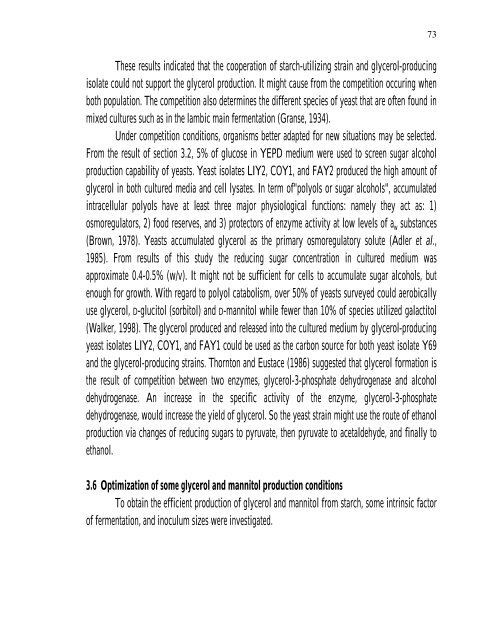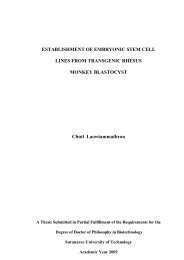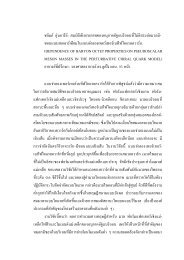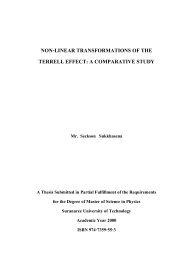PRODUCTION Of NUTRIENT SOURCES FOR RHIZOBIUM
PRODUCTION Of NUTRIENT SOURCES FOR RHIZOBIUM
PRODUCTION Of NUTRIENT SOURCES FOR RHIZOBIUM
You also want an ePaper? Increase the reach of your titles
YUMPU automatically turns print PDFs into web optimized ePapers that Google loves.
These results indicated that the cooperation of starch-utilizing strain and glycerol-producing<br />
isolate could not support the glycerol production. It might cause from the competition occuring when<br />
both population. The competition also determines the different species of yeast that are often found in<br />
mixed cultures such as in the lambic main fermentation (Granse, 1934).<br />
Under competition conditions, organisms better adapted for new situations may be selected.<br />
From the result of section 3.2, 5% of glucose in YEPD medium were used to screen sugar alcohol<br />
production capability of yeasts. Yeast isolates LIY2, COY1, and FAY2 produced the high amount of<br />
glycerol in both cultured media and cell lysates. In term of"polyols or sugar alcohols", accumulated<br />
intracellular polyols have at least three major physiological functions: namely they act as: 1)<br />
osmoregulators, 2) food reserves, and 3) protectors of enzyme activity at low levels of a w substances<br />
(Brown, 1978). Yeasts accumulated glycerol as the primary osmoregulatory solute (Adler et al.,<br />
1985). From results of this study the reducing sugar concentration in cultured medium was<br />
approximate 0.4-0.5% (w/v). It might not be sufficient for cells to accumulate sugar alcohols, but<br />
enough for growth. With regard to polyol catabolism, over 50% of yeasts surveyed could aerobically<br />
use glycerol, D-glucitol (sorbitol) and D-mannitol while fewer than 10% of species utilized galactitol<br />
(Walker, 1998). The glycerol produced and released into the cultured medium by glycerol-producing<br />
yeast isolates LIY2, COY1, and FAY1 could be used as the carbon source for both yeast isolate Y69<br />
and the glycerol-producing strains. Thornton and Eustace (1986) suggested that glycerol formation is<br />
the result of competition between two enzymes, glycerol-3-phosphate dehydrogenase and alcohol<br />
dehydrogenase. An increase in the specific activity of the enzyme, glycerol-3-phosphate<br />
dehydrogenase, would increase the yield of glycerol. So the yeast strain might use the route of ethanol<br />
production via changes of reducing sugars to pyruvate, then pyruvate to acetaldehyde, and finally to<br />
ethanol.<br />
3.6�Optimization of some glycerol and mannitol production conditions<br />
To obtain the efficient production of glycerol and mannitol from starch, some intrinsic factor<br />
of fermentation, and inoculum sizes were investigated.<br />
��






